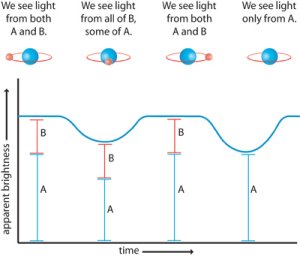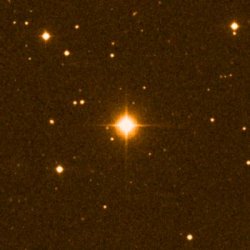eclipsing binary

Simulated light curve from an eclipsing binary. Image credit: ESA.
An eclipsing binary is a binary star system in which the components periodically pass in front of one another as seen from Earth. When this happens the total light received from the system is reduced. The primary minimum occurs when the component with the higher surface luminosity is eclipsed by its fainter companion.
Three main types of eclipsing binary are distinguished on the basis of their light curves: Algol stars, Beta Lyrae stars, and W Ursae Majoris stars. Eclipses may also occur in some kinds of cataclysmic binary, including dwarf novae, novae, and symbiotic stars. Exactly how the light varies depends on the nature of the component stars and their separation.
Algol star
An Algol star, named after the prototype, Algol, has periods of constant or near-constant brightness between minima, indicating that the two stars form a close binary of the detached or semidetached kind. Thousands of examples are known, with periods ranging from about five hours to 30 years and brightness variations of up to several magnitudes. In most cases where mass transfer takes place, it is by direct accretion rather than by an accretion disk. However, an extreme group of eclipsing, mass-transferring binaries, known as W Serpentis stars or "hyperactive Algols", do have accretion disks and may be in a pre-Algol-type stage. Algol stars are among the most important kind of star systems in terms of the information they provide on stellar masses and sizes.
Beta Lyrae star
A Beta Lyrae star is a type of close binary star system that is both an ellipsoidal variable and an eclipsing binary. The secondary minimum of a Beta Lyrae variable is intermediate between that of a Beta Persei star and a W Ursae Majoris star. Even when the components are not in eclipse, we view them from different angles and see a different amount of light, so that the brightness changes are fairly smooth and continuous, unlike the abrupt changes of a normal eclipsing system. The prototype is Beta Lyrae.
R Canis Majoris star
An R Canis Majoris star is a semidetached eclipsing binary, in which the less massive component almost fills its Roche lobe. The prototype varies in brightness from magnitude 6.7 to 5.9 (roughly doubling) in a period of 27 hours.
Ursae Majoris star
 |
| W Ursae Majoris. Photo: ESO Online Digitized Sky Survey. |
A W Ursae Majoris star is a type of eclipsing binary with a very short period of a few hours up to a day. In W UMa systems, the component stars, which are of spectral type F or G and lie on or near the main sequence, form a contact binary and have pulled each other into teardrop shapes. The primary and secondary minima are virtually the same (some 0.6 to 0.8 magnitude deep) and there is a continuous light variation throughout the orbit, with no clear start or end to an eclipse.
W Ursae Majoris itself lies 162 light-years away and consists of two stars not unlike the Sun, the primary with a mass of 0.99 solar mass, a radius of 1.14 solar radius, and a luminosity 1.45 times that of the Sun, and the secondary with a mass of 0.62 solar mass, a radius of 0.83 solar radius, and a solar-equivalent luminosity.


